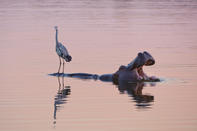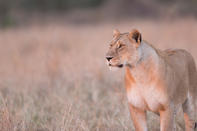An Atmosphere of Adventure and Romance
The lodges and camps found in the Sabi Sands Game Reserve are as comfortable as they are atmospheric and beautiful. In the midst of the African Wilderness, the Malamala gardens are as famed as the wild animals that roam through them, Londolozi boasts a dining room built halfway up a giant ebony tree and the Sabi Sabi lodges are impeccably designed with an air of informal elegance.

The area is rich in wild animals and vegetation of considerable variety. Trails wind through wild gardens peppered with prolific birdlife. Up to 130 species can be seen at hides like Warthog Wallow and Puzamanzi. The Sabi Sands Game Reserve has an atmosphere of adventure and romance which has remained from the days when safari traders, hunters, traders and explorers moved through the area.
There are no fences on the reserve so the animals are free to roam where they wish and the wild gardens have been developed to become a tourist showpiece of Southern Africa.
Far away from the city, the pressures and artificialities of a modern lifestyle are left behind when visitors enter Sabi Sands. Visitors are housed in dreamlike accommodation and taken on guided game-viewing drives by experienced rangers, who are trained to lead guests in observing all aspects of the wilderness from big game and wild predators to small creatures, trees and grasses.
Driving deep into the wilderness in an open four-wheel-drive vehicle, raw nature is so close you can touch it. Rides at dawn, sunset and night immerse visitors in the sounds, smells and incredible views of the Southern African bushveld.
The Selati Railway

Apart from seeing and feeling all that nature has to offer, the original Selati railway also runs through the western side of the reserve. A part of Southern African history, the route of the line along with gravesites of construction workers can still be seen in areas of the park. There used to be a station at Newington (where there is a gate to enter Sabi Sands), an area renowned for its lions.
While waiting for trains, passengers would often sit perched in thorn trees to guard against a lion attack, so much so that authorities in the area provided ladders for climbing trees in an emergency. Eventually, the station at Newington was closed and the Selati line relocated.
Sabi Sands can also be accessed from the Skukuza airfield (24 km away from Malamala and 30 km away from Londolozi) in the Kruger National Park or from the main tarred road leading from Hazyview to the Paul Kruger Gate of the Kruger Park. When using the road, the turnoff to access Sabi Sands is 37 km down the road, 20 km away from the Paul Kruger Gate. The Sabie River Lodge can be found 14 km along the road.
Learning About Wilderness Conservation
An interesting part of visiting areas like Sabi Sands is addressing the challenges of conserving the wilderness. With the human population exploding and cities developing at the rate that they are, special care needs to be taken in wilderness conservation areas such as Sabi Sands and the influences of such developments need to be studied.
Even though the animals have access to a large area in which to roam, their habitat is still artificially constructed and their natural migration patterns are disrupted, which has its effects not only on the animals but the natural vegetation that has to accommodate their permanent presence. The roads, tracks, petrol fumes and waste of the humans that venture through the reserve also has its impact on the animals and vegetation.
Circumstances in the reserve, as well as events like droughts, floods and the invasion of alien plant species, requires close observation and some control to ensure the wellbeing of the area and its inhabitants. Learning about these challenges in the relaxed environment of the lodge proves to be an education to many visitors who leave with deeper thoughts other than the spectacular memories of their encounters with raw nature.
 Experience pure luxury in the heart of South Africa's ultimate Big Five sanctuary while staying at accommodation in Sabi Sand Game Reserve....
Experience pure luxury in the heart of South Africa's ultimate Big Five sanctuary while staying at accommodation in Sabi Sand Game Reserve.... Sabi Sand is a private nature reserve named after the Sabie River and Sand River: the two main rivers which flow through it. It is made up o...
Sabi Sand is a private nature reserve named after the Sabie River and Sand River: the two main rivers which flow through it. It is made up o...